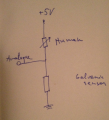Overview
Bioelectronics
Bioelectronics is the field of research in the convergence of biology and electronics ( "A Framework for Bioelectronics: Discovery and Innovation". National Institute of Standards and Technology. February 2009. p. 42.)
- All matter has electrical properties. Electricity is an essential ingredient of matter
“Sources for information about the field include the Institute of Electrical and Electronics Engineers (IEEE) with its Elsevier journal Biosensors and Bioelectronics published since 1990. The journal describes the scope of bioelectronics as seeking to : "... exploit biology in conjunction with electronics in a wider context encompassing, for example, biological fuel cells, bionics and biomaterials for information processing, information storage, electronic components and actuators. A key aspect is the interface between biological materials and micro- and nano-electronics."[1] (wikipedia, https://en.wikipedia.org/wiki/Bioelectronics)
“Organic Bioelectronics is the application of organic electronic material to the field of Bioelectronics. Organic materials (i.e. containing carbon) show great promise when it comes to interfacing with biological systems.[Owens, Róisín; Kjall, Peter; Richter-Dahlfors, Agneta; Cicoira, Fabio (September 2013). "Organic bioelectronics — Novel applications in biomedicine". Biochimica et Biophysica Acta 1830 (9): 4283–4285. doi:10.1016/j.bbagen.2013.04.025. PMID 23623969. Retrieved 17 February 2016.]”(wikipedia, https://en.wikipedia.org/wiki/Bioelectronics)
Implants and Prosthesis
artificial vision
(Epiretinal implants, stimulation of the optic nerve and stimulation of the lateral geniculate nucleus)
“The idea of an epiretinal implant is an electrode array on the inside of the eye, lying on the surface of the retina, directly stimulating the retinal ganglion cells. An external camera and microprocessor is used to capture and process the image, and in turn stimulate the electrode array either by cable or wirelessly.”(Lucas van Dijk “Rewiring the brain – creating artificial vision”)
(Artificial vision: needs, functioning, and testing of a retinal electronic prosthesis Gerald J. Chader)
“The optic nerve is also a potential site for the implantation of a visual prosthesis.”(ibid)
“Stimulating the lateral geniculate nucleus is one of the more recent approaches of creating artificial phosphenes [10]. Phosphene creation is done by placing electrodes in the right areas and stimulating those areas in the lateral geniculate nucleus, where the visual field is well structured.”(ibid)
Brain Pacemakers
(malfunction in the motor cortex results in Parkinson’s Disease or depression) “Doctors know that deep brain stimulation works as a therapy for Parkinson’s disease. But they’re still trying to figure out why and how.”(http://spectrum.ieee.org/the-human-os/biomedical/devices/how-brain-pacemakers-treat-parkinsons-disease) “De Hemptinne and colleagues had previously discovered that people with Parkinson’s disease have an abnormal amount of _synchronicity_ [pdf] between low-frequency beta waves and high-frequency gamma waves. Specifically, the beta waves’ phase correlated with the gamma waves’ amplitude. In this new study, the researchers showed that DBS reduces this synchronization.”(ibid)
Artificial cardiac pacemaker
“Cardiac pacemaker is a medical device which uses electrical impulses, delivered by electrodes contracting the heart muscles, to regulate the beating of the heart. The primary purpose of a pacemaker is to maintain an adequate heart rate, either because the heart's natural pacemaker is not fast enough, or because there is a block in the heart's electrical conduction system.”(wikipedia, https://en.wikipedia.org/wiki/Artificial_cardiac_pacemaker)
“Modern pacemakers usually have multiple functions. The most basic form monitors the heart's native electrical rhythm. When the pacemaker does not detect a heartbeat within a normal beat-to-beat time period, it will stimulate the ventricle of the heart with a short low voltage pulse. This sensing and stimulating activity continues on a beat by beat basis. The more complex forms include the ability to sense and/or stimulate both the atrial and ventricular chambers.”(ibid) https://en.wikipedia.org/wiki/File:Fluoroscopy_pacemaker_leads_right_atrium_ventricle.png https://en.wikipedia.org/wiki/File:PaceMakerRemoteMonitoringDevicesTwoKinds.jpg
Electronics. Basics
Forrest Mims. “Getting Started in Electronics.” - Basic Electronics by Radio Shack Engineer's - Electronics for dummies (pdf)
atom
free electrons
direct current (dc) electricity
alternating current (ac) electricity
multimeter
transducer
antenna, sensors, arduino (A transducer is a device that converts one form of energy to another.) “Transducers are often employed at the boundaries of automation, measurement, and control systems, where electrical signals are converted to and from other physical quantities (energy, force, torque, light, motion, position, etc.).”(wikipedia, https://en.wikipedia.org/wiki/Transducer) “Bidirectional transducers convert physical phenomena to electrical signals and also convert electrical signals into physical phenomena. Examples of inherently bidirectional transducers are antenna (radio)s, which can convert conducted electrical signals to or from propagating electromagnetic waves, and voice coils, which convert electrical signals into sound (when used in a loudspeaker) or sound into electrical signals (when used in a microphone).”(ibid) Antenna – converts propagating electromagnetic waves to and from conducted electrical signals https://en.wikipedia.org/wiki/File:Signal_processing_system.png
Biofeedback
(conductivity and resistance)
- Landwehr, Kuni: Home Made Bio Electronic Arts: Do-it yourself: Microscopes, Sensors, Sonifications ISBN 978-3856165673 (Introduction)
- Landwehr, Kuni: Home Made Bio Electronic Arts: Do-it yourself: Microscopes, Sensors, Sonifications ISBN 978-3856165673 (Projects)







